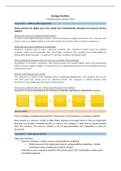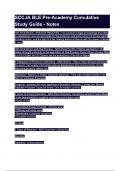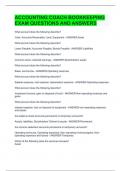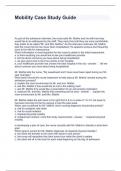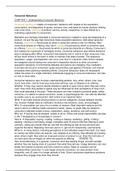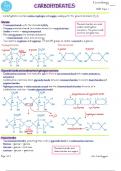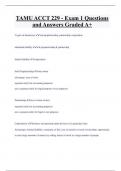BASIC MEASUREMENTS AND QUESTIONNAIRE DESIGN
Adapted from: S.H. van Deventer, (2011) Study Guide for PYC2606, Basic Measurement and Questionnaire Design, University of South Africa, Pretoria
, CONTENT DOMAIN
HOW TO IDENTIFY THE CONTENT DOMAIN FOR A QUESTIONNAIRE
The function of the questionnaire is measurement.
It is an important tool for data collection.
A questionnaire is a set of questions drawn up with the aim of obtaining information on a specific topic.
It is not used to answer research questions that aim to investigate the relation between different topics.
IDENTIFYING THE FOCUS OF THE QUESTIONNAIRE
Before you can draw up a questionnaire, you need to have a clear idea of the purpose of the
questionnaire.
The purpose of the questionnaire refers to what it intends to measure and for whom it will be used.
The people who complete the questionnaire are the target population
The purpose of the questionnaire will in turn give you ideas about the content domain (the possible
tasks, behaviours, attitudes, etc.)
It is from this content domain that you select items to make up the questionnaire.
Step 1: identify the general topic of interest.
Step 2: select a problem area/area of interest within that topic
Step 3: reduce the general problem to more specific questions.
Having identified these questions, you have established the focus of your questionnaire.
LIMITING THE SCOPE OF THE QUESTIONNAIRE
Relating to the questions that you could ask.
Your questionnaire will serve no purpose if the questions are not directly related to the focus or purpose
it is designed for.
The next step is to limit the scope of the questionnaire.
Scope: the extent or range of observation or action.
Need to decide on what is relevant for your questionnaire. Guidelines (ask):
(1) Enough questions to cover content domain adequately
(2) Only questions that are directly relevant to content domain.
Adapted from: S.H. van Deventer, (2011) Study Guide for PYC2606, Basic Measurement and Questionnaire Design, University of South Africa, Pretoria
, Limit the scope of the questionnaire; decide what is directly relevant to the focus If the questions don’t
seem relevant, the respondents might not want to complete the questionnaire.
Once a list of the aspects you want to cover is made, look at each one and ask “Is this directly relevant”
and “why?”
This forces you to have to ensure there is a good reason why each question is included in the
questionnaire.
By limiting the scope in this way, you can cover the topic adequately but still have a questionnaire that is
relevant and not too long.
Adapted from: S.H. van Deventer, (2011) Study Guide for PYC2606, Basic Measurement and Questionnaire Design, University of South Africa, Pretoria
, CORRELATION COEFFICIENT
HOW TO USE CORRELATION COEFFICIENT IN ITEM ANALYSIS
In psychological research one is often interested in the possible relation between two psychological
constructs.
A construct is an unobservable quality which forms part of a theory designed to explain observable
behaviour. Examples are anxiety, intelligence, stress, independence.
Researchers design and develop questionnaires to measure these constructs and then calculate a statistic
known as a correlation coefficient to tell them more about the relation between the constructs.
THE CORRELATION COEFFICIENT
If there is a relationship between two constructs it means that a person’s relative position (compared to
other people) on one construct bears a relation to his or her relative position on the other construct.
A positive relationship implies that relatively high scores on one construct are associated with relatively
high scores on the other and relatively low scores on the first correspond with relatively low scores on the
second.
This implies that as scores on the one construct increase, there are increases in the scores on the other
construct.
A negative relationship on the other hand implies that high scores on one construct are associated with
low scores on the other construct.
If the constructs are not related, changes on the one do not correspond with changes on the other.
The statistical relationship between two constructs is called a correlation and the statistic used to describe
this is called a correlation coefficient.
The correlation coefficient can range in value from -1,00 to +1,00.
These values represent a perfect negative (-1) and a perfect positive correlation (+1).
A value close to 0 indicates a weak relationship while 0 represents no correlation.
You can see that the numerical size of a correlation coefficient indicates the strength of the relationship
while the sign (positive/negative) indicates the direction of the relationship.
THE SCATTER PLOT
The graphic display of the correlation coefficient is called a scatter plot.
The graph consists of a horizontal line (called a horizontal axis) and a vertical line (or vertical axis) that
meet at an angle of 90 degrees.
Adapted from: S.H. van Deventer, (2011) Study Guide for PYC2606, Basic Measurement and Questionnaire Design, University of South Africa, Pretoria
Adapted from: S.H. van Deventer, (2011) Study Guide for PYC2606, Basic Measurement and Questionnaire Design, University of South Africa, Pretoria
, CONTENT DOMAIN
HOW TO IDENTIFY THE CONTENT DOMAIN FOR A QUESTIONNAIRE
The function of the questionnaire is measurement.
It is an important tool for data collection.
A questionnaire is a set of questions drawn up with the aim of obtaining information on a specific topic.
It is not used to answer research questions that aim to investigate the relation between different topics.
IDENTIFYING THE FOCUS OF THE QUESTIONNAIRE
Before you can draw up a questionnaire, you need to have a clear idea of the purpose of the
questionnaire.
The purpose of the questionnaire refers to what it intends to measure and for whom it will be used.
The people who complete the questionnaire are the target population
The purpose of the questionnaire will in turn give you ideas about the content domain (the possible
tasks, behaviours, attitudes, etc.)
It is from this content domain that you select items to make up the questionnaire.
Step 1: identify the general topic of interest.
Step 2: select a problem area/area of interest within that topic
Step 3: reduce the general problem to more specific questions.
Having identified these questions, you have established the focus of your questionnaire.
LIMITING THE SCOPE OF THE QUESTIONNAIRE
Relating to the questions that you could ask.
Your questionnaire will serve no purpose if the questions are not directly related to the focus or purpose
it is designed for.
The next step is to limit the scope of the questionnaire.
Scope: the extent or range of observation or action.
Need to decide on what is relevant for your questionnaire. Guidelines (ask):
(1) Enough questions to cover content domain adequately
(2) Only questions that are directly relevant to content domain.
Adapted from: S.H. van Deventer, (2011) Study Guide for PYC2606, Basic Measurement and Questionnaire Design, University of South Africa, Pretoria
, Limit the scope of the questionnaire; decide what is directly relevant to the focus If the questions don’t
seem relevant, the respondents might not want to complete the questionnaire.
Once a list of the aspects you want to cover is made, look at each one and ask “Is this directly relevant”
and “why?”
This forces you to have to ensure there is a good reason why each question is included in the
questionnaire.
By limiting the scope in this way, you can cover the topic adequately but still have a questionnaire that is
relevant and not too long.
Adapted from: S.H. van Deventer, (2011) Study Guide for PYC2606, Basic Measurement and Questionnaire Design, University of South Africa, Pretoria
, CORRELATION COEFFICIENT
HOW TO USE CORRELATION COEFFICIENT IN ITEM ANALYSIS
In psychological research one is often interested in the possible relation between two psychological
constructs.
A construct is an unobservable quality which forms part of a theory designed to explain observable
behaviour. Examples are anxiety, intelligence, stress, independence.
Researchers design and develop questionnaires to measure these constructs and then calculate a statistic
known as a correlation coefficient to tell them more about the relation between the constructs.
THE CORRELATION COEFFICIENT
If there is a relationship between two constructs it means that a person’s relative position (compared to
other people) on one construct bears a relation to his or her relative position on the other construct.
A positive relationship implies that relatively high scores on one construct are associated with relatively
high scores on the other and relatively low scores on the first correspond with relatively low scores on the
second.
This implies that as scores on the one construct increase, there are increases in the scores on the other
construct.
A negative relationship on the other hand implies that high scores on one construct are associated with
low scores on the other construct.
If the constructs are not related, changes on the one do not correspond with changes on the other.
The statistical relationship between two constructs is called a correlation and the statistic used to describe
this is called a correlation coefficient.
The correlation coefficient can range in value from -1,00 to +1,00.
These values represent a perfect negative (-1) and a perfect positive correlation (+1).
A value close to 0 indicates a weak relationship while 0 represents no correlation.
You can see that the numerical size of a correlation coefficient indicates the strength of the relationship
while the sign (positive/negative) indicates the direction of the relationship.
THE SCATTER PLOT
The graphic display of the correlation coefficient is called a scatter plot.
The graph consists of a horizontal line (called a horizontal axis) and a vertical line (or vertical axis) that
meet at an angle of 90 degrees.
Adapted from: S.H. van Deventer, (2011) Study Guide for PYC2606, Basic Measurement and Questionnaire Design, University of South Africa, Pretoria

